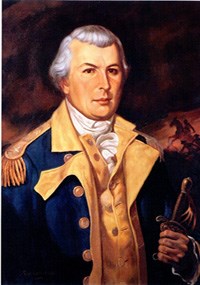
Robert Wilson oil painting, 1978 Nathanael Greene was born in Rhode Island in 1742 to Quaker parents. His education, though not formal, revealed that he was a good student. He possessed a keen mind, excelled in mathematics and spent many hours reading in Greek and Roman classics. His family business—iron forging for ships—became his trade. After the "Gaspee' Affair" in 1775, in which his family was accused of involvement in burning a British revenue ship, Greene began to take an interest in the growing discontent in the colonies. It was this interest that led him to the military, a choice that was in conflict with his religious upbringing. At the outbreak of the American Revolution in 1775, Greene helped raise a company of militia called the "Kentish Guards." Greene joined as a private armed with a musket bought from a British deserter. A childhood affliction forced him to limp, a disqualification for a soldier in the ranks, but his abilities as a leader were quickly recognized. In May 1775, Greene was commissioned as a brigadier general of militia commanding the three regiments raised in Rhode Island for service with Washington's army at Boston. The following June Greene received his Continental commission and two months later was promoted to major general. His innate military skill soon made him Washington's best-trusted subordinate. After the miserable winter at Valley Forge, there were calls for a change in the quartermaster department, which had failed in its ability to feed and clothe the army. Greene was asked to take charge and remedy the situation. Greene reluctantly accepted the offer by Washington and performed remarkably well reforming and reorganizing the department. Greene's new methods did not please all members of the Congress. When they refused him a vote of confidence, Greene resigned in July 1780. His next assignment was to command the defenses of the upper Hudson River, to replace the former commander, the treacherous Benedict Arnold. Following the disastrous Battle of Camden, South Carolina, in August 1780, Congress asked Washington to advise a replacement commander for the Southern Department. Greene was immediately recommended and was appointed to command in October. Taking charge of the remnants of the Southern Army in December, Greene's conduct of the war in the South for the next three years was to be so successful that it broke the back of the British war effort in America. During the Southern Campaign Greene used the same successful system of supply he had used under Washington. To guarantee payment to his contractors he gave his personal guarantee of payment. At war's end in 1783, Greene was forced to sell most of his personal property to retire these debts to his name. While attempting to rebuild his finances he settled at "Mulberry Grove," a plantation given to him and his wife, Catherine Littlefield Greene, and their five children, by the people of Georgia. Here, in June 1786, Greene died from what may have been the complications of sunstroke, never seeing the beginning of the new country he had fought to create. |
Last updated: September 14, 2015
